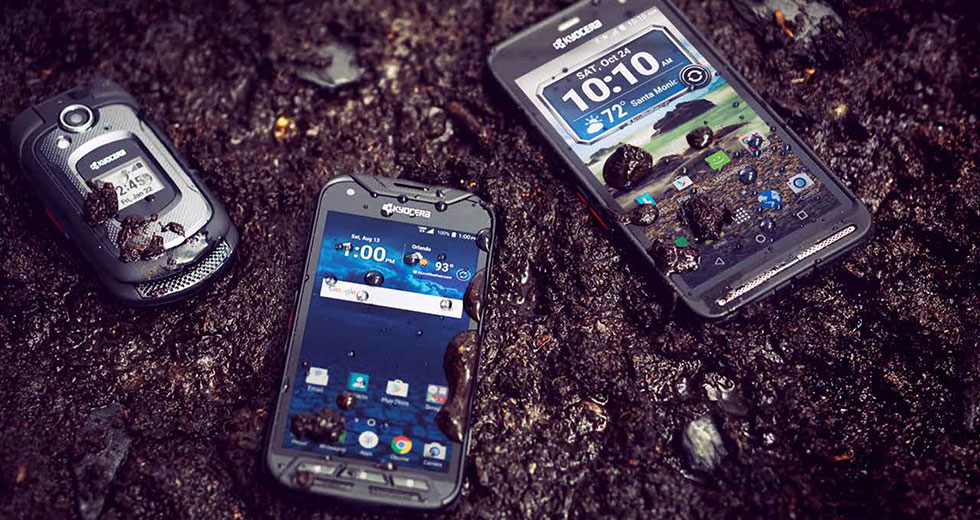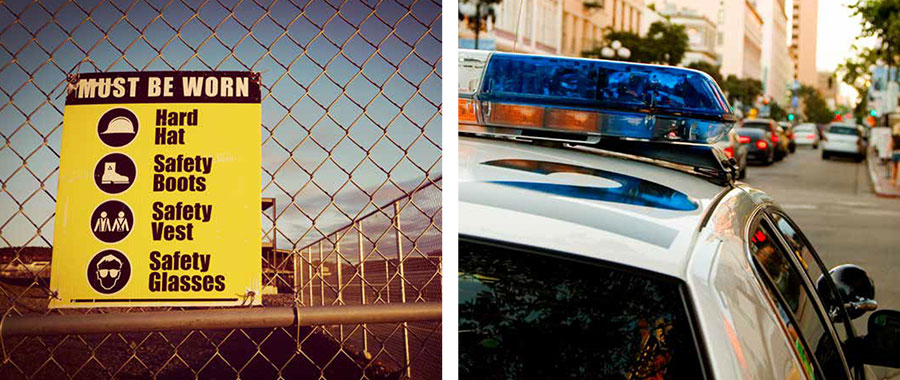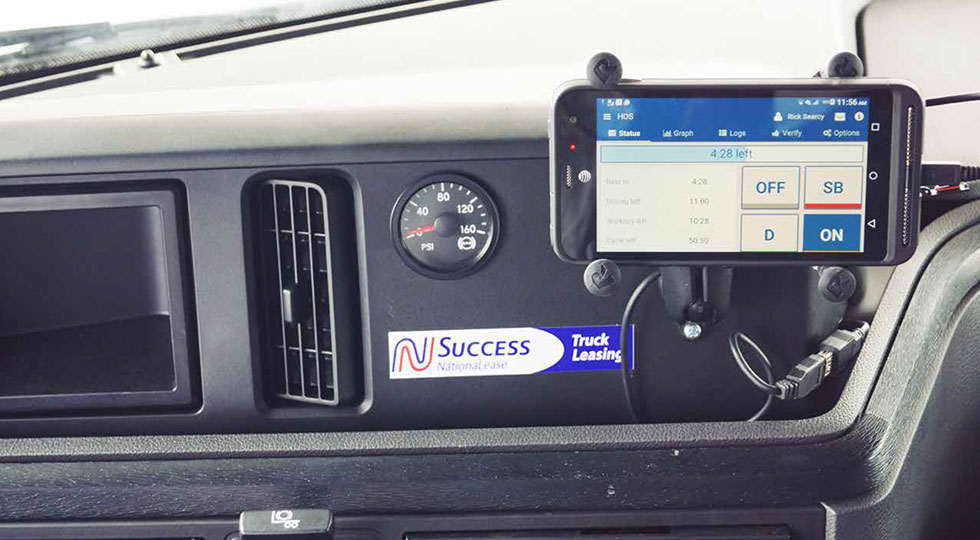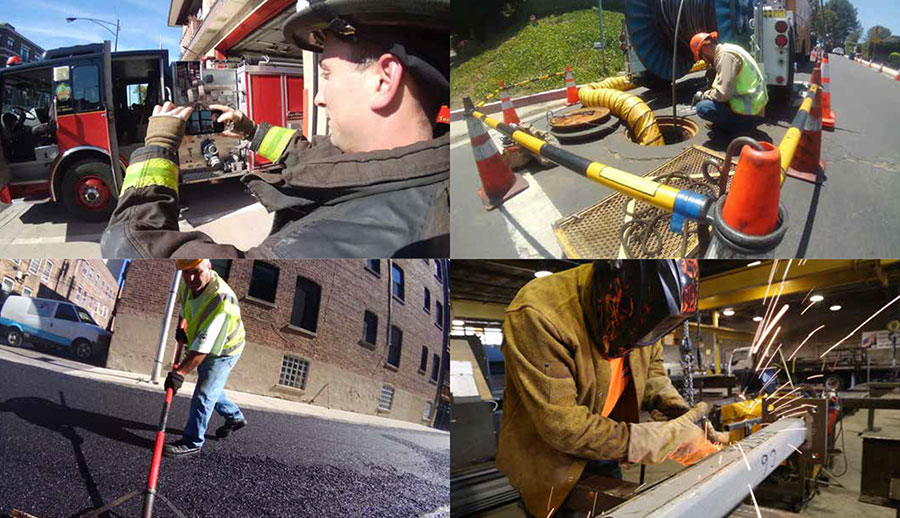Rugged for a reason: Building mobile devices for a new wave of users
There was a time, not so long ago, when owning a smartphone was a luxury. Today, however, it's a necessity. Our lives are intrinsically tied to our mobile devices, as we depend on constant access to data. As smartphone ownership and usage increase, the demands of consumers and businesses are changing. New operating systems, better cameras, voice assistants and apps that deliver whatever we need are, according to many surveys, considered as important to our everyday lives as food, water and sleep. And as our dependence grows, the demand for rugged devices that can stand up to the bumps and bruises of the real world grows with it. From enterprises and businesses to the adventure-seeking consumer, rugged devices that can survive and thrive in the most challenging settings are on the rise.
A RUGGED NEW ERA IN MOBILE
According to a 2016 report by VDC Research, the demand for rugged features is growing
at a steady pace, especially in the world of business: "Over the next 18 months, 79
percent of organizations are planning new mobile device deployments to front-line
workers. The use of rugged tablets (60 percent) will dominate future deployments with
consumer-grade smartphones (55 percent) following closely behind. Moreover, companies
note feeling some motivation to reconsider their consumer-grade investments because
they realize the cost of consumer devices is not too different from purpose-built
rugged mobile devices. In addition, more modern, rugged devices have closed the gap in
terms of ergonomics and modern user interface, making it easier for employees to
understand and use."¹
And the mobile industry is taking notice. More and more manufactures are incorporating rugged features into their devices, including water- and shock-proofing. The mobile industry, however, faces a complicated challenge when it comes to designing rugged devices. Most manufacturers have been racing to create thinner, lighter devices with more technological firepower. Rugged devices, by nature, require more bulk. Thus, manufacturers have focused more on making devices water resistant, leaving the weather-, dust- and shock-proofing out – or at least to aftermarket cases. The mobile-accessories market is a bellwether for the rugged demand, with revenues projected to rise to more than $100 billion by 2020². And aftermarket protective cases, which provide some level of ruggedization (at a cost both monetary and in usability), are the industry's fastest growing accessory segment.

THE RISE OF RUGGED
Myriad factors have led to the rise in demand for rugged devices, including a younger
generation with more adventurous lifestyles, businesses recognizing mobile communications
as a productivity tool and the emergence of the smartphone as a 24-hour-a-day necessity
for both personal and business use. Smartphones are a significant investment, and consumers
and business users alike are increasingly demanding features that protect that investment.
According to analyst research, 86 percent of consumers expect their next devices to have at
least one rugged feature³. And in a testament to their value, 95 percent of those who
use rugged devices for work are not planning to replace them with non-rugged devices¹.
Rugged, however, is more than simply protection from the elements. The demand for rugged is
surging because the data that drives our society – be it for business or personal use
– is accessed most often through mobile devices.
With more and more personal and business data living online and in the cloud, rock-solid security is also imperative for consumers – and even more so for enterprises. A hack into a single device can expose a consumer to identity theft or an entire company's proprietary information. In short, smartphones need to be tough and secure inside and out.
Consumers and enterprises are increasingly demanding a trifecta of value that includes durability, functionality and security. Rugged makes financial sense as well – rugged devices can save 46 percent on the cost of business mobility, as well as extend the life of devices4. Kyocera is one of the mobile leaders taking on the challenge of creating a lightweight, technologically advanced and truly rugged smartphone, with the DuraForce PRO. Packed with features like fingerprint security, an advanced action camera, wireless charging and the latest Android OS, DuraForce Pro keeps up with the Joneses on features, but surpasses the competition by implementing cutting-edge technology, including true water-, shock- and dust-proofing, in a rugged device certified to military standards for toughness. The device includes extensive security measures into its rugged devices, including biometric fingerprint authentication, Android for Work, a user-ID encryption engine, FIPS 140-2 encryption and more. Kyocera partners with industry leaders like AirWatch, SOTI and Google/Android to ensure security on each and every device meets and exceeds industry standards.

BUILDING DEVICES THAT ARE BUILT TO LAST
The word "rugged" has many meanings (at least seven in the dictionary). But when it comes to
mobile devices, the meaning of "rugged" becomes much more specific. While many devices claim
to be rugged, there is an existing set of standards for protection against the elements and
the everyday dangers of life. Truly rugged devices are designed for certification to globally
recognized Ingress Protection (IP) standards for protection from dust and liquids, and Military
Standard 810G for protection against dust, shock, vibration, temperature extremes, blowing
rain, low pressure, solar radiation, salt fog, thermal shock, icing and freezing rain, humidity
and water immersion.
Meeting these standards requires much more than an aftermarket case or partial water resistance. The standards were developed to ensure that devices would function in critical moments for organizations and the military while operating in incredibly harsh conditions. An example of this demand comes from Blueforce Development Corporation, a company focused on providing products and services that enhance safety, increase operational efficiency and enable better decisions, primarily in the defense, law-enforcement and security industries. With a need for ultra-tough devices that meet "HAZLOC" (or "Hazardous Location") Class I Division 2 standards, Blueforce has repeatedly endorsed Kyocera rugged devices – specifically Kyocera's Brigadier and DuraForce Series ruggedized smartphones – for providing workers in high-risk settings smartphones certified for protection in hazardous locations where concentrations of flammable gases, vapors or mists are not normally present in an explosive concentration, but may accidentally exist.
Michael Helfrich, CEO of Blueforce Development Corporation, described recent testing his company did with Kyocera and other smartphones. "The Kyocera devices and their operators were deployed throughout a one-kilometer underground tunnel, and the combined solution performed flawlessly during this pilot test. The Brigadier also delivered noted reliability in a high-heat environment, consistently providing 8-10 hours of battery life with Blueforce Tactical [software] running on the device nonstop. Meanwhile, other mobile devices succumbed to the heat and simply stopped operating during the testing."
Devices engineered to rugged standards traditionally have been expensive and not available to individual consumers. A significant rise in consumer demand for rugged features, however, has changed the approach for both manufactures and service providers. While consumer-market manufacturers have focused mainly on the race to provide the latest bells and whistles in a tug of war for market share, Kyocera has dedicated years of research and development to create truly rugged and technologically-advanced devices with capabilities that serve consumer and enterprise needs today and in the future. By combining years of designing more standard consumer devices with its expertise in engineering and service for enterprise customers, Kyocera is even bringing enterprise and military-grade rugged devices to the consumer market.

RUGGED: FACT VERSUS FICTION
While standards for rugged certifications are very specific and clear, the term "rugged" is
thrown around much more loosely in today's consumer market. Many devices claim to be rugged
and waterproof, but they're not always comparing apples to apples. To earn an IP certification
for waterproofing, devices must be able to survive being submerged in water for 30 minutes
without permanent damage. Many leading smartphones do not quite hold up to scrutiny. The
Kyocera DuraForce series, including DuraForce PRO, however, does meet the stringent IP68
certification standard for water- and dust-proofing.
Rather than trying to overlay durability features on an off- the-shelf consumer device, Kyocera designs its devices to be rugged from the beginning. While other manufacturers often use technologies aimed at surviving in the event of water ingress, Kyocera uses design tools like gaskets, air-permeable waterproof membranes and even rubberized screws to prevent water from ever entering its devices. This technology makes the device dust and dirt-proof as well. And with features like Glove & Wet Touchscreen Operation, Kyocera's devices not only survive exposure, they thrive in it and keep their users connected and productive.
And it's not just the phone's electronics that must withstand punishment. Drops are the most common cause of damage to mobile devices – and screens are most often the victims. The Kyocera DuraForce PRO is certified to Military Standard 810G for protection against shock and vibration, and able to withstand (without an aftermarket case) a drop from 6.5 feet. Kyocera certifies within the 810G standard and also tests its devices to survive heavy dust environments, high altitudes (15,000 feet for at least two hours), solar radiation, exposure to salt fog and extensive humidity. While these conditions may seem harsh and irregular to the average mobile-device user, they are becoming more and more commonplace for workers who operate in rugged environments and require mobile connectivity to drive workflows, as well as a new breed of adventure-seeking consumers who want to capture their experiences without worrying about damaging their devices.
The market now demands rugged devices, but the marketing for rugged can be deceiving. The best way to ensure devices are truly up to the challenge is to measure them by rugged standards like IP68 and Military Standard 810G. And look closely at a device's fine print. There's a big difference between a device that is "designed to" these standards and a device that is CERTIFIED to these standards.
DOING MORE WITH MOBILE
The rise of rugged is being driven not only by a demand for tougher devices, but also a demand
for more features that allow users to do more with their devices on a daily basis. Push-To-Talk
(PTT) functionality has long been a necessity for certain businesses like construction and
transportation. Today, 4G LTE networks have boosted PTT's coverage and functionality for both
businesses and consumers.
PTT is a value-added feature for consumers – and a boon to businesses that would otherwise need to build out private Land Mobile Radio (LMR) networks to connect their teams with one-to-one or one-to-many walkie-talkie-style communications. According to Kodiak, a provider of one of the leading PTT platforms that operates across LMR, LTE and Wi-Fi networks, the annual cost per carrier-integrated PTT user is 55 percent less than the expense of supporting a user on a private LMR network. Kyocera integrates a dedicated PTT button on all of its rugged devices, which can be utilized with major carriers, including Verizon, Sprint, and AT&T. The PTT button can also be programmed or integrated into a variety of apps – like Pool Bus and FleetComplete – which turn devices into transportation monitoring tools.

LIFE IS A VISUAL MEDIUM
In the social-media age, everything is documented and visualized. It's no wonder high-quality
cameras are a key feature for most consumers on their devices. Every major manufacturer seems
to include an upgraded camera with each new product release, but now it is more important to
develop cameras with more than just added megapixels and editing features.
Kyocera's rugged DuraForce PRO features a super-wide-view HD action camera, which can even be used underwater – as well as in harsh conditions – allowing adventurous users to document their experiences, and allowing business users to share visual data from almost any environment. The DuraForce PRO also offers a 13MP camera and a 5MP front-facing camera, in addition to the wide-view action camera, so that users can capture everything from sports to live feeds to business-critical video.
A PRUDENT INVESTMENT
While rugged devices are just now making a splash in the consumer market, they have been
used by businesses that rely on teams in the field – like construction and manufacturing
– for more than 20 years. These traditional rugged devices were typically offered only
to enterprises by specialized manufacturers and came with a hefty price tag. In today's
data-driven society, however, the need for rugged has expanded to include almost every
business and every consumer. Advanced technology, fueled by surging demand, has made rugged
devices available to the masses at an affordable price.
According to VDC Research, the overall market for Hazardous Location-certified rugged handheld and tablet mobile computers was estimated at almost $70 million in 2015 and is forecasted to reach $111 million by 20195.
Rugged devices are now available to both consumers and businesses, and can offer a lower total cost of ownership (TCO) than non-rugged devices. Rugged devices hold value for a far longer period of time than their non-rugged counterparts: they cost less in repairs and replacement, do not require expensive aftermarket cases, and – most importantly – function reliably in critical environments, ensuring that business can function without interruption. Rugged devices are no longer a luxury item – they are a sound investment.
THE FUTURE OF RUGGED MOBILE
As data and instant communication continue to drive our lives and businesses, the
mobile device will evolve to include more data-driven functionality – and become an
even more critical component to our lives and jobs than they are today. The inevitable
shrinking of technology will allow more power to be packed into lighter and thinner
devices. The realities of life in the physical word, however, will remain mostly
unchanged – making rugged devices increasingly important for both businesses and
consumers. Kyocera will continue to be a leader in rugged technology, creating innovative
solutions that allow consumers and business to do more.
FOR MORE INFORMATION ABOUT KYOCERA DEVICES FOR BUSINESS, PLEASE VISIT
kyoceramobile.com/business
1. "Enterprise Mobile Buyer Behavior Dataset and Forecast Models" VDC Research, June 17, 2016.
2. "Mobile Accessories Revenues to Total $81.5 Billion in 2015", https://www.abiresearch.com/press/mobile-accessories-revenues-total-815-billion-2015/, published October 29, 2015.
3. COMSCORE (from Kyocera History PDF)
4. VDC and Kyocera 2015 survey
5. "Mobile Applications in Hazardous Manufacturing Environments", VDC Research, May 4, 2016.
© 2017 Kyocera Communications International, Inc. (KCI), San Diego, California, USA. All rights reserved. No reproduction in whole or in part is allowed without prior written approval. Kyocera is a registered trademark of Kyocera Corporation.